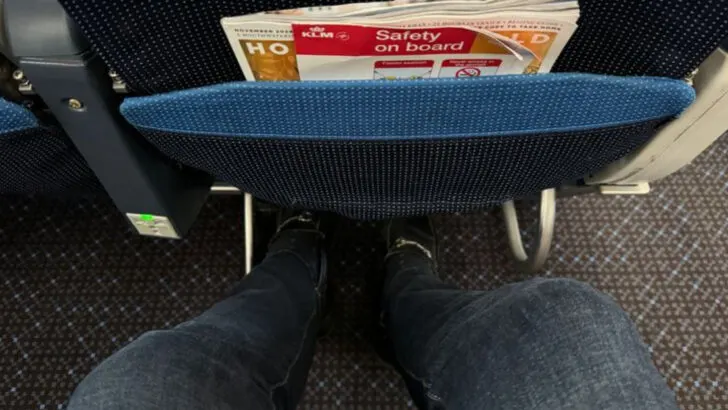Frequent flyers know the skies have rules—and not all of them are printed on your boarding pass. Ask any seasoned traveler, and they’ll tell you: what you wear on a plane can make or break your flight. From fabrics that trap every drop of sweat to outfits that seem comfortable—until hour five hits—you’ll find out fast that comfort and practicality rule the cabin.
These aren’t style tips from fashion magazines; they’re survival lessons learned at 30,000 feet. Before you dress for your next departure, see what frequent flyers refuse to wear—and the painful lessons behind their choices.
Tight Jeans
There’s nothing quite like the feeling of finally sitting down, only to realize your jeans are squeezing the life out of you. Frequent flyers steer clear of tight jeans due to their restrictive nature. Sitting for extended periods can become unbearable.
Moreover, tight jeans can affect circulation, leading to discomfort or even health issues like deep vein thrombosis. Opting for looser, more breathable fabrics can make a world of difference.
This choice is more than just about comfort; it’s about ensuring a relaxed journey. Freedom of movement is key when you’re thousands of feet in the air.
High Heels
Wearing high heels on a plane might seem like a fashion statement, but practicality often triumphs over style for experienced travelers. Airplanes can be turbulent, and balancing in heels can be tricky.
Additionally, comfort is sacrificed for aesthetics. Long flights mean swollen feet, and tight heels can exacerbate the problem. Selecting comfortable footwear ensures ease and reduces the risk of injury.
Frequent flyers favor sneakers or slip-ons for easy transition through security and enhanced comfort during the flight. Functionality and comfort take precedence in the skies.
Heavy Fragrances
Did you know? Scent sensitivity is a real concern on flights. Heavy fragrances can be overwhelming in the confined space of a cabin, leading to discomfort for fellow passengers.
Frequent flyers understand the importance of keeping the air breathable. Strong perfumes can trigger allergies or headaches among sensitive travelers.
Opting for mild or no fragrance is a considerate choice. It’s a small gesture ensuring a pleasant journey for everyone on board. Air travel is a shared experience, and respect for others’ comfort is paramount.
Flip Flops
Flip flops might scream vacation mode, but savvy travelers know they’re not ideal for air travel. They offer little support and protection in bustling airports.
In emergencies, secure footwear is essential. Flip flops can cause slips or hinder movement. They’re not the best choice when navigating crowded terminals or during evacuations.
Comfortable, supportive shoes are a must for frequent flyers. They provide stability and ease, making journeys smoother. Air travel demands readiness for various scenarios, and footwear plays a crucial role.
Metal Accessories
Passing through airport security is a breeze—unless you’re adorned with metal accessories. Frequent flyers avoid them to save time and hassle.
Metal detectors react to jewelry, belts, and more, leading to additional screening. This can be frustrating when you’re in a rush to catch a flight.
Minimalistic choices in accessories mean smoother transitions through security. It’s a savvy strategy that enhances travel efficiency. Less is more when it comes to air travel, and seasoned travelers know this well.
Ill-Fitting Suits
Frequent flyers in business attire know that an ill-fitting suit can be more of a burden than a boon. A suit too tight or loose can cause discomfort during long flights.
Proper fit is crucial for maintaining a professional yet comfortable look. Wrinkled or constricting suits can leave a poor impression and make travel unpleasant.
Travelers opt for wrinkle-resistant fabrics and tailored fits to ensure they arrive looking sharp and feeling at ease. Comfort and professionalism can coexist seamlessly with the right attire choices.
Synthetic Fabrics
Synthetic fabrics might seem convenient, but they can quickly become a nightmare on long flights. These materials often trap heat and moisture, leading to discomfort.
Frequent flyers prefer natural fabrics like cotton or linen for their breathability. These materials allow the skin to breathe and regulate temperature during the flight.
Choosing the right fabric can transform the flying experience from stifling to soothing. It’s an often overlooked aspect of travel attire that frequent flyers pay attention to, ensuring a more pleasant journey.

